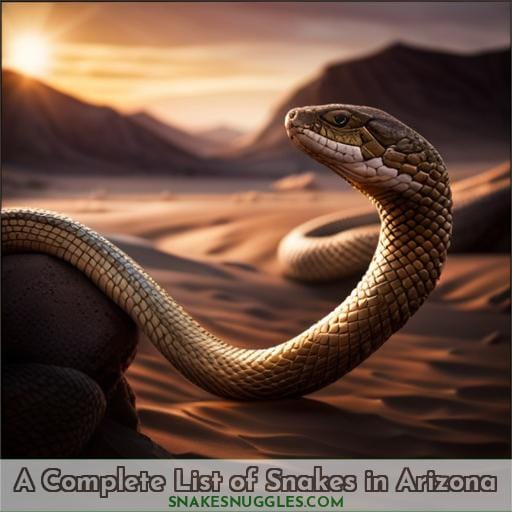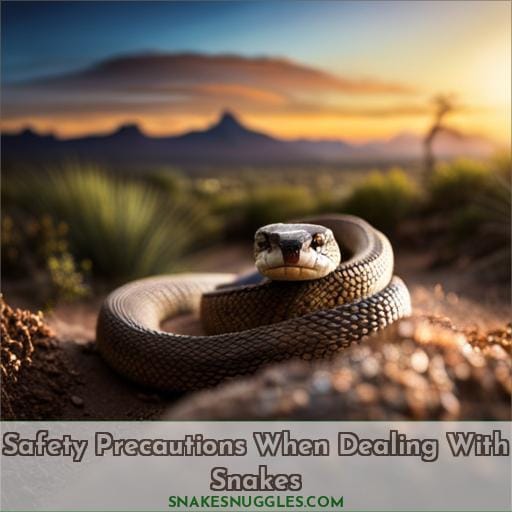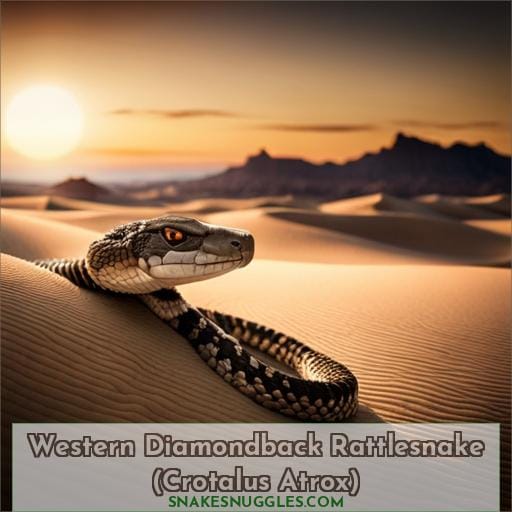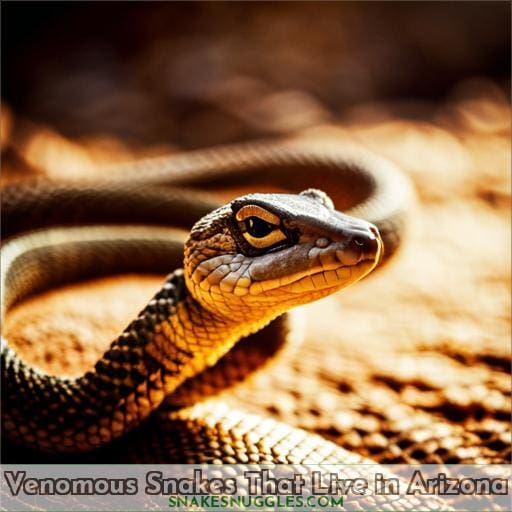This site is supported by our readers. We may earn a commission, at no cost to you, if you purchase through links.
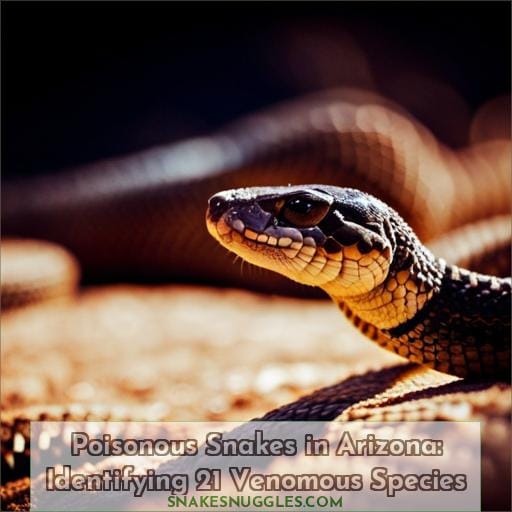
It is important to know how to identify these poisonous snakes and take safety precautions when encountering them outdoors. Additionally, it’s equally important to understand not only their habitats but also to respect their natural environment so that everyone can peacefully coexist with these reptiles in Arizona.
To make sure you stay safe while exploring our beautiful state, brush up on your knowledge about the different species of venomous snakes living here – from Western Diamondbacks all the way down to Coral Snakes!
Table Of Contents
- Key Takeaways
- Venomous Snakes in Arizona
- Nonvenomous and Common Snakes in Arizona
- A Complete List of Snakes in Arizona
- Safety Precautions When Dealing With Snakes
- Coexisting With Snakes in Arizona
- Western Diamondback Rattlesnake (Crotalus Atrox)
- Common Non-poisonous Arizona Snakes
- Venomous Snakes That Live in Arizona
- Western Massasauga
- Additional Help Identifying Venomous Snakes
- Frequently Asked Questions (FAQs)
- Conclusion
Key Takeaways
- Arizona is home to 21 venomous snake species, each with distinct characteristics and behaviors.
- Venomous snakes possess potent venoms that can lead to severe pain, tissue damage, or even death.
- Understanding snake behavior is key to avoiding bites.
- Seeking immediate medical assistance is crucial if bitten by a snake.
Venomous Snakes in Arizona
Arizona is home to a variety of venomous snakes, including the Western Diamondback Rattlesnake (Crotalus atrox), Mohave Rattlesnake (Crotalus scutulatus), Sidewinder (Crotalus cerastes), and Coral Snake (Micrurus fulvius).
These species are known for their potent venoms, which can cause severe pain, tissue damage, or even death. It’s important to be aware of these creatures when exploring Arizona’s diverse landscapes.
Western Diamondback Rattlesnake
Be wary of the Western Diamondback Rattlesnake, a recognizable snake with distinct diamond-shaped markings and an aggressive nature that packs a powerful punch if provoked. It has an average lifespan of 20 years in the wild and can grow up to 3 feet long.
Defensive strategies include shaking its tail rattle or flattening out its body when threatened. Its venom contains numerous components, such as neurotoxins, which cause severe pain, tissue damage, paralysis, and even death in rare cases.
Tracking methods involve observing sand tracks left behind by this reptile’s unique locomotion behavior, while food preferences consist mostly of small rodents like lizards, mammals, and birds.
When it comes to these snakes, always remember: Respect their habitat from afar for your own safety!
Mohave Rattlesnake
You will recognize the Mohave Rattlesnake by its pale color and black diamond pattern, but be aware that this species is among the most venomous snakes in North America. Its neurotoxic venom can cause severe effects to humans if bitten, so it’s best to avoid provoking or handling them.
They thrive in arid regions of Arizona and prefer snake habitats away from people. To ensure safe coexistence with these creatures, it is important to educate others about their behaviors and respect their natural environment.
A potent bite can even lead to paralysis risk; always keep safety precautions in mind when dealing with rattlesnake species like the Mojave Rattlesnake found throughout Poisonous Snakes in Arizona region known as Venomous Snakes!
Sidewinder
Experience the thrill of encountering a sidewinder as it navigates its way through the Arizona desert. The sidewinder’s unique locomotion adaptation allows it to traverse rocky terrain with ease and makes a mimicry behavior of rattlesnakes when threatened.
Its venom potency is less than that of other snakes, but it still causes pain and swelling. Prey hunting involves ambushing lizards, small animals, or birds before quickly constricting them with its coils in order to feed.
Compared to the western diamondback rattlesnake or Mohave Rattlesnake, which has neurotoxic venom that affects the nervous system, sidewinders have a startle display similar to tiger rattlesnakes and rock rattlesnakes.
Coral Snake
Behold the vibrant banding pattern of the coral snake, a rare and potentially paralyzing species in Arizona’s deserts. With venomous traits, this reptile is capable of inflicting paralysis upon its prey or those attempting to handle it.
It usually displays reclusive behavior but can be identified by its bright colors and distinct head shape.
Coexisting tips include respecting their habitats from a safe distance and wearing protective clothing when around them. Venomous snakes such as the coral snake are essential for maintaining ecosystems but must be approached with caution due to their potential risks.
Understanding these creatures allows us to safely coexist within our shared environment.
Nonvenomous and Common Snakes in Arizona
Surrounded by deserts, mountain ranges, and grassy plains, Arizona is home to a variety of snakes. Commonly found in the state are the Arizona Milk Snake (Lampropeltis triangulum), Glossy Snake (Arizona elegans), Desert Kingsnake (Lampropeltis getula splendida), Blackneck Garter snake (Thamnophis cyrtopsis ocellatus), as well as Sonoran Gopher Snakes (Pituophis catenifer affinis).
These species have adapted to their environments over time and play an important role in maintaining balance within ecosystems.
Arizona Milk Snake
Admire the Arizona Milk Snake, known for its bold red-and-black patterned bands. Found in a variety of habitats throughout Arizona, it is part of the state’s diverse snake ecology. This harmless species typically displays shy behavior when threatened and can be identified by looking for a white or yellow Y shape on its head.
Conservation efforts have been undertaken to protect this species, as well as other types found in the region such as Western Rattlesnakes, Twin Spotted Rattlesnakes, Lyre Snakes, and Ridge Nosed Rattlesnake.
Learn more about snakes native to this area to help identify them from afar so you can enjoy their beauty without fear!
Glossy Snake
The Glossy Snake is an incredible sight with its shimmering scales and slender body. It can even climb trees, which makes it stand out from other Arizona snakes! This nonvenomous species has a glossy anatomy that allows it to blend into its environment.
Its behavior consists of hunting small prey like lizards and rodents for food sources in the desert or grasslands habitats where they live. Although they are not dangerous, humans should still approach them with caution as their bites may cause pain and swelling due to the potent venom found in their saliva glands.
With knowledge of these creatures’ behaviors and requirements, we can better coexist safely alongside this amazing creature!
Desert King Snake
You can find the Desert King Snake in Arizona. It is a species of harmless and slender snake with distinctive black stripes and yellowish-brown coloration. The snake is well adapted to desert habitats. It uses mimicking tactics similar to rattlesnakes or Mexican vine snakes for protection.
Unlike many venomous snakes, its bite does not cause paralysis but will still induce mild swelling and pain. This nonvenomous predator feeds on small mammals, bird eggs, and lizards when given the chance due to its predatory behavior.
The Western Shovel Nose Snake looks very similar, so caution should be taken when observing them in their natural habitat! Safety precautions, such as protective clothing, should always be used around these animals, even if they are harmless.
Blackneck Garter Snake
Behold the majestic Blackneck Garter Snake, with its distinctive black stripes on a yellow-green body. This nonvenomous creature is found in desert habitats across the Southwest and can reach up to three feet long.
It feeds mainly on small prey like insects and amphibians, using predator mimicry to protect itself from larger predators such as rattlesnakes or Western Massasauga snakes.
Adaptations include changing coloration for camouflage in various environments; some may even be mistaken for venomous species like the Sidewinder Rattlesnake due to similar markings! Nevertheless, these harmless creatures are an important component of western ecosystems, playing their part alongside other non-poisonous Arizona snakes, including the Bullsnake and Sonoran Gopher Snake.
Sonoran Gopher Snake
Marvel at the Sonoran Gopher Snake, a camouflaged desert dweller that can be found in arid regions of Arizona.
This species is active during the day and preys on lizards, rodents, eggs, and other reptiles. It inhabits areas such as Southwestern Blackhead Snakes or Grand Canyon Rattlesnake habitats.
By respecting their environment, they coexist with many venomous snakes like the speckled rattlesnake, which should not be handled due to its effects on tissue damage or even death if provoked by humans.
Therefore, through knowledge, we can protect these animals’ habitat while still admiring them from a safe distance for our own safety without disrupting nature’s balance.
A Complete List of Snakes in Arizona
Discover the incredible creatures living in Arizona’s diverse habitats, from rattlesnakes to gopher snakes. There are five types of venomous species – Western Diamondback Rattlesnake, Mohave Rattlesnake, Sidewinder, Coral Snake – and four non-venomous ones – Gopher Snake, Sonoran Gopher Snake, Coachwhip snake, and Bullsnake.
For those who want to coexist safely with these reptiles, it is important for them to understand their behavior as well as the effects of their venom should they be encountered or bitten by one. Species identification is also necessary when out in nature, particularly if you plan on exploring areas where rattlers such as Hopi Rattlesnakes, Northern Blacktail Rattlesnakes, or Prairie Rattlesnakes may be present.
Additionally, there’s a variety of other desert-dwelling snakes like Arizona Milk Snakes, which can easily blend into their surroundings thanks to their coloration.
Lastly, remember that the protection of these amazing animals’ habitats must come first before anything else, so we all have an opportunity to enjoy our time outdoors while respecting wildlife at the same time!
Safety Precautions When Dealing With Snakes
When dealing with snakes, it is important to take safety precautions. Protective clothing should always be worn when outdoors in snake habitats, and venomous species must be identified so that appropriate medical help can be sought if necessary.
It is essential to understand the risks associated with these creatures and respect their natural environment.
Protective Clothing
When exploring snake habitats, it’s essential to wear protective clothing for your safety. This includes long pants and closed-toe shoes made from durable fabric. It also includes multiple layers of comfortable clothes that allow freedom of movement.
Additionally, consider wearing items with additional safety features like gaiters or boots. Venomous snakes, such as the coachwhip snake or the monster rattlesnake, can deliver neurotoxic bites that cause swelling and pain.
Wearing proper clothing can reduce the risk when encountering these creatures. Pay attention to warning signs, such as mimicry behavior, if a non-venomous species appears aggressive. This could be indicative of an approaching venomous snake nearby. Protective garments not only provide physical protection but also peace of mind while navigating through potentially dangerous areas inhabited by reptiles in Arizona’s diverse landscapes.
Identifying Venomous Species
It is essential to be able to recognize the venomous species of snakes found in Arizona. Western Diamondback Rattlesnakes are distinguished by diamond-shaped markings and a rattle, while Mohave Rattlesnakes have neurotoxic venom that affects the nervous system.
Sidewinders possess less potent venom but still cause pain and swelling, whereas Coral Snakes have vibrant banding patterns with potentially paralyzing effects from their bite.
Identifying these snakes can help protect against snake bites as well as understand symptoms like severe pain or tissue damage if bitten. Seeking medical attention for antivenom treatment is crucial for safety. Knowing how to distinguish between poisonous and non-poisonous species such as Gopher Snake, Sonoran Gopher Snake, Coachwhip Snake, Bullsnake, or Western Patch-nosed Snake also allows us to coexist safely with them in their natural environment.
Seeking Medical Help
If you’ve been bitten by a snake, it’s important to seek medical help immediately. Venom can cause severe pain, tissue damage, and even death in some cases. Therefore, seeking treatment quickly and understanding the characteristics of the snake are essential preventative measures for avoiding any potential risks of venom poisoning.
It’s also important to be aware of what type of antivenom may be available for that particular species, as well as its range, in order to effectively treat a bite from that specific kind of snake. Medical care should always include further investigation into the specifics of how snakes reproduce and their other basic physical features, such as size or coloration pattern.
This information could provide valuable insights for identifying symptoms or determining severity levels for each individual case involving a suspected poisonous reptile encounter.
Coexisting With Snakes in Arizona
It is important to be mindful of the natural environment when coexisting with snakes in Arizona. Respect for snake habitats and admiring them from a safe distance is a critical step for humans to ensure their safety while living alongside these creatures.
By understanding and respecting these animals, we can all live harmoniously in nature’s ecosystem.
Respecting Snake Habitats
Admiring snakes from a distance allows us to respect their habitats while coexisting safely. To ensure respectful encounters, it’s important to be aware of the snake defense mechanisms and recognize venomous myths.
Habitat conservation is key for the safe admiration of black snakes, including the Gopher Snake in the Sonoran Desert and other snake habitats. Understanding behavior patterns helps us identify warning signs and respond appropriately when encountering one on our travels.
Admiring From a Safe Distance
When observing snakes in Arizona, stay a safe distance away to avoid any potential harm; how close is too close? Respectful viewing can be done without getting too near. Admiring safely means being aware of defensive displays and signs of aggression.
Learning about the different snake species found in the desert will help with poison awareness–some are venomous while others aren’t.
Western Diamondback Rattlesnake (Crotalus Atrox)
Arizona is home to a variety of venomous snakes, including the Western Diamondback Rattlesnake (Crotalus atrox), Mohave Rattlesnake (Crotalus scutulatus), Sidewinder (Crotalus cerastes), and Coral Snake (Micrurus fulvius).
These creatures play an important role in Arizona’s ecosystems but can be dangerous when encountered. Therefore, it is important to understand these snakes’ behaviors and take precautions accordingly.
Mohave Rattlesnake (Crotalus Scutulatus)
Discover the Mojave Rattlesnake, a venomous snake found in Arizona’s arid regions with distinct black diamond patterning. It is among the most poisonous snakes in North America and displays defensive behavior when threatened.
This species has adapted to its desert environment through camouflage coloring and unique locomotion habits, allowing it to thrive among abundant wildlife. The highly potent neurotoxic venom of this rattlesnake can cause paralysis as well as tissue damage or death if left untreated; however, coexistence with these creatures is possible by understanding their diet habits and respecting their habitats from a safe distance.
Sidewinder (Crotalus Cerastes)
Behold the Sidewinder, its unusual track locomotion undulating across desert sands. Its venom potency is less than that of other Arizona snakes, but it still causes pain and swelling when bitten. The Sidewinder is well-adapted to diverse landscapes and displays defensive behavior when threatened.
It has a unique coloration pattern that mimics gopher snake mimicry, which helps deter predators. Although not as deadly as some of its counterparts, a bite from this species can still pose a risk of paralysis.
This highlights the importance of their role in maintaining ecosystem balance. Respecting these creatures will ensure that humans can coexist safely alongside them without sacrificing safety or understanding about their roles within ecosystems.
Coral Snake (Micrurus Fulvius)
Admire the vibrant banding pattern and potent neurotoxic venom of the Coral Snake, found in arid regions throughout Arizona. This species is highly venomous and should be observed from a safe distance. Identification can be made by its distinct red, yellow, and black bands – though it may resemble other harmless snakes.
The effects of its bite include paralysis risk along with pain and swelling when left untreated. However, this snake does not display aggression when threatened like some others in Arizona’s ecosystems.
Common Non-poisonous Arizona Snakes
Not all snakes in Arizona are venomous. Five of the most common non-poisonous species include the Gopher Snake (Pituophis catenifer), Sonoran Gopher Snake (Pituophis catenifer affinis), Coachwhip Snake (Masticophis flagellum), Bullsnake (Pituophis catenifer sayi), and Western Patch-nosed Snake (Salvadora hexalepis).
These harmless reptiles thrive in a variety of habitats, from deserts to grasslands, where they feed on insects, rodents, and other small animals.
Gopher Snake (Pituophis Catenifer)
See the Gopher Snake, an impressive desert-dweller with its own mimicking defense mechanisms. Its behavioral mimicry and locomotion methods help it blend into its environment, while its coloration patterns allow for predator deterrence.
It feeds on small prey, which it constricts before consuming, and is known to display aggression if threatened. The Gopher Snake is well adapted for life in Arizona’s deserts; thanks to these adaptations, this reptile can thrive alongside humans without posing a threat of danger or harm.
Sonoran Gopher Snake (Pituophis Catenifer Affinis)
The Sonoran Gopher Snake, a desert-adapted species with camouflage coloring, slithers swiftly in arid Arizona. Behavior mimicry and defensive tactics often fool predators. It feeds on small prey like lizards, rodents, and insects while relying on its adaptations to survive the harsh conditions of the desert.
Camouflage coloring helps it blend into its environment and hide from potential threats. Its long body allows for swift movement across sand dunes as well as climbing trees when necessary to escape danger or hunt for food.
Coachwhip Snake (Masticophis Flagellum)
You can spot the Coachwhip Snake by its slender body and fast locomotion, making it well-suited for desert landscapes. This species lacks venomous traits but displays defensive behaviors when threatened.
Its whip-like appearance is a result of unique locomotion styles that allow it to traverse sand and gravel with ease. It prefers arid regions such as deserts, shrublands, and grasslands where they feed on lizards, small mammals, birds, or eggs during daylight hours.
Though harmless to humans, this snake should be admired from a safe distance due to its ability to climb surfaces if provoked. With respect for their habitats, this species can coexist safely in Arizona’s natural environment.
Bullsnake (Pituophis Catenifer Sayi)
Admiring the bullsnake, you’ll notice its unique coloration, which typically ranges from yellow to reddish-brown and can reach up to 8 feet in length. It is an agile climber with a varied diet of mammals, birds, eggs, and reptiles.
Its locomotion involves mainly slithering, but sometimes it will also use sidewinding when moving over sand or other loose soils.
Bullsnakes are nonvenomous, so they rely on defense mechanisms such as hissing loudly or flattening their head like cobras do when threatened, instead of venom potency, for protection against predators.
Their banding pattern consists mostly of dark blotches along its back, which helps provide camouflage in various environments. This allows them to coexist peacefully with humans without harm if respected from a safe distance while admiring these fascinating creatures’ feeding habits during the day in Arizona’s diverse landscapes.
Western Patch-nosed Snake (Salvadora Hexalepis)
Bearing a yellowish-orange hue and black stripes, the Western Patch-nosed Snake is an eye-catching desert dweller. Identification can be challenging due to its varying coloration, which helps it blend in with its environment.
This snake’s diet primarily consists of lizards, rodents, and insects; however, they also employ tactics such as mimicry and predator deterrence for protection. Conservation of their habitat is critical since this species relies heavily on camouflage coloration for survival from potential predators.
With increased threats from human activity, understanding these creatures’ habits is essential so that people may coexist safely in their natural environment.
Venomous Snakes That Live in Arizona
Arizona is home to several venomous snakes, such as the Western Diamond-backed Rattlesnake, Rock Rattlesnake, Black-tailed Rattlesnake, Mojave Rattlesnake, and Hopi Rattlesnake. These species have potent venom that can cause severe pain or tissue damage in humans if they are disturbed or threatened.
It is important for people living in Arizona to take caution around these animals and understand their behavior while coexisting with them safely.
Western Diamond-backed Rattlesnake
The Western Diamond-backed Rattlesnake is a common Arizona reptile recognizable by its diamond-shaped markings and tail rattle. Its venom can cause severe pain, tissue damage, or even death in rare cases. It displays defensive behaviors when threatened and prefers arid regions for habitats.
This species has pale coloration with black diamond patterning that aids in camouflage for protection from predators. Tracking methods involve leaving behind distinct sand tracks due to its unique locomotion style of moving sideways instead of forward like other snakes do.
The Smiths had an unfortunate encounter last summer near Phoenix after being bitten by one such rattlesnake, which resulted in them requiring anti-venom treatment at the hospital. Thankfully, they were able to recover fully without any lasting effects from the bite itself or its venomous consequences.
Rock Rattlesnake
Behold the Rock Rattlesnake, an impressive reptile with its distinct grey-brown coloration and black bands. Typically found in rocky habitats from Arizona to New Mexico, this venomous snake uses a unique sidewinding locomotion to navigate terrain.
Its behaviors are typically defensive when it feels threatened but can be quite aggressive if cornered or disturbed. It also utilizes camouflage as a survival tactic against predators by blending into its natural environment.
With powerful venom that causes severe pain and tissue damage, the Rock Rattlesnake is not one to be trifled with, yet it still plays an important role in nature’s delicate balance – best admired from afar!
Black-tailed Rattlesnake
Watch out for the Black-tailed Rattlesnake, which is found in Arizona and has a distinct black band across its tail. It’s known to be one of the most venomous species in North America; its neurotoxic venom affects the nervous system if it injects any amount into prey or predators.
This snake thrives in arid regions due to its desert living habits, but can also pose a threat when encountered as it displays aggression when threatened. Its powerful bite causes severe pain and tissue damage, with even rare cases of death occurring from more serious bites.
Be sure to take safety precautions such as avoiding provoking them, wearing protective clothing while outdoors, and seeking medical help immediately if bitten by this rattlesnake!
Mojave Rattlesnake
Be aware of the Mojave Rattlesnake – one of North America’s most venomous snakes, boasting a pale color and black diamond pattern. It thrives in arid regions of Arizona with a neurotoxic venom that affects the nervous system.
Identification tips include its size, distinct markings, and rattling tail. Bite prevention includes avoiding provocation or handling them, plus wearing protective clothing in habitats. Habitat conservation is important for these predators who mimic rattlesnakes to deter other creatures from attacking them.
Hopi Rattlesnake
Gaze in awe at the magnificent Hopi Rattlesnake! These medium-sized rattlers can reach up to three feet long and live mainly in Arizona’s Mohave desert. They are carnivorous, with their diet consisting of small rodents, lizards, birds, and even other snakes.
Their venom is potent but rarely fatal to humans. They use mimicry for defense instead of attack. The Hopi Rattlesnakes’ reproduction cycle begins after a brief courtship period. During this time, males compete for mates before mating takes place near rock crevices or burrows that provide shelter from predators.
In short, these incredible creatures play an essential role by controlling rodent populations.
Western Massasauga
Take a step back and admire the Western Massasauga, its subtle yet vibrant stripes shining brilliantly like fireworks across an inky night sky. This venomous snake is found amongst Arizona’s rocky desert habitats. Its potency rivals that of other rattlesnakes, but it prefers to use defensive behaviors such as flattening its body against the ground or vibrating its tail before striking when threatened.
As far as prey selection goes, it feeds on small mammals and lizards while relying on camouflage patterns for protection from predators. The Western Massasauga also has special adaptations that make it well-suited for dry desert climates, including burrowing abilities and nocturnal activity levels to conserve energy during hot days.
This allows it to survive in this environment successfully with minimal water intake required from outside sources due to its efficient kidneys.
With an understanding of these creatures’ behavior comes safety: respect snake habitats, wear protective clothing if necessary, and identify venomous species so you can be prepared should you come across one out there!
Additional Help Identifying Venomous Snakes
Learning to identify venomous species in Arizona can help you stay safe. There are four main types of poisonous snakes found in the state: the Western Diamondback Rattlesnake, the Mohave Rattlesnake, the Sidewinder, and the Coral Snake.
The Western Diamondback is recognized by its distinct diamond-shaped markings and tail rattle. It displays aggression when threatened and has a potent venom that causes severe pain and tissue damage, although death is rare.
The Mohave rattler also has an extremely toxic neurotoxic venom. It is characterized by pale color with black diamond patterning.
The Sidewinder has a less powerful bite, but it still causes swelling and pain. This snake has a unique sand track locomotion for desert survival.
Lastly, there’s the Coral snake, which predominantly preys on small mammals during daytime hours. It poses a paralysis risk from its vibrant banding patterned neurotoxin if provoked or handled carelessly.
Knowing these symptoms, as well as respecting their habitats, will ensure your safety around these creatures. You can coexist peacefully without any fear of harm or injury occurring from encounters with them.
Frequently Asked Questions (FAQs)
What is the best way to identify a venomous snake?
To identify a venomous snake, look for distinct diamond-shaped markings and a rattle on the tail. Observe its behavior; if it is aggressive or reclusive, caution is advised. Study the coloration and banding patterns as well as any neurotoxic properties of its venom.
Are there any venomous snakes that live in urban areas?
Yes, some venomous snakes can live in urban areas. Common examples include the Western Diamondback Rattlesnake, Mohave Rattlesnake, and Sidewinder.
What is the best way to avoid being bitten by a venomous snake?
To avoid a venomous snake bite, remain alert and vigilant when outdoors. Wear protective clothing and maintain your distance if you encounter one. Show respect for their habitat by refraining from provoking or handling them, and also educate others on how to do the same.
Are there any venomous snakes in Arizona that are endangered?
Yes, the Mojave Rattlesnake is an endangered species found in Arizona. It has a neurotoxic venom and a pale color with a black diamond pattern.
What are the long-term effects of a venomous snake bite?
Venomous snake bites can cause severe pain, tissue damage, and even death in rare cases. Long-term effects may include paralysis, organ failure, and reduced mobility. It’s important to remain cautious when encountering snakes to ensure your safety.
Conclusion
From the beautiful Sonoran Desert to the lush forests of Oak Creek Canyon, Arizona is home to a variety of venomous and non-venomous snakes. These creatures play an important role in the ecosystems of the state but can be dangerous when encountered.
As such, it’s important for Arizonans to identify and understand the different species of poisonous snakes that call the state home. In total, there are 21 known venomous snakes in Arizona, including the Western Diamondback Rattlesnake, Mohave Rattlesnake, Sidewinder, and Coral Snake.
To stay safe, it’s essential to wear protective clothing when in snake habitats, be able to identify venomous species, and seek medical help if bitten. By respecting snake habitats and admiring from a safe distance, humans can coexist safely with these creatures in their natural environment.
Ultimately, understanding the various poisonous snakes in Arizona will help ensure the safety of all.


